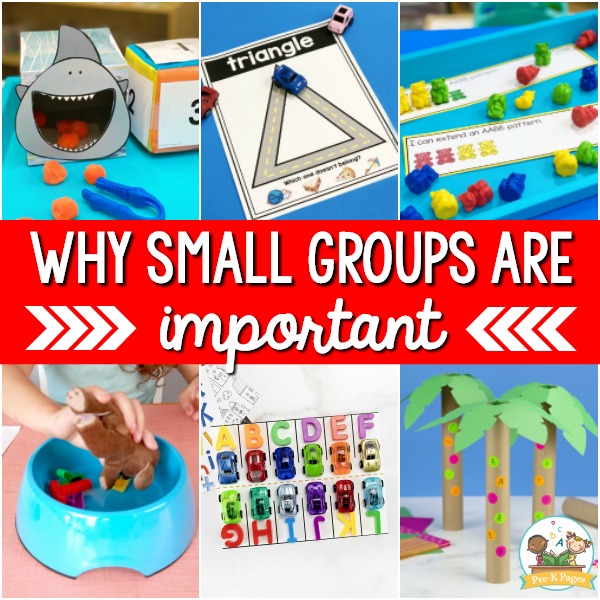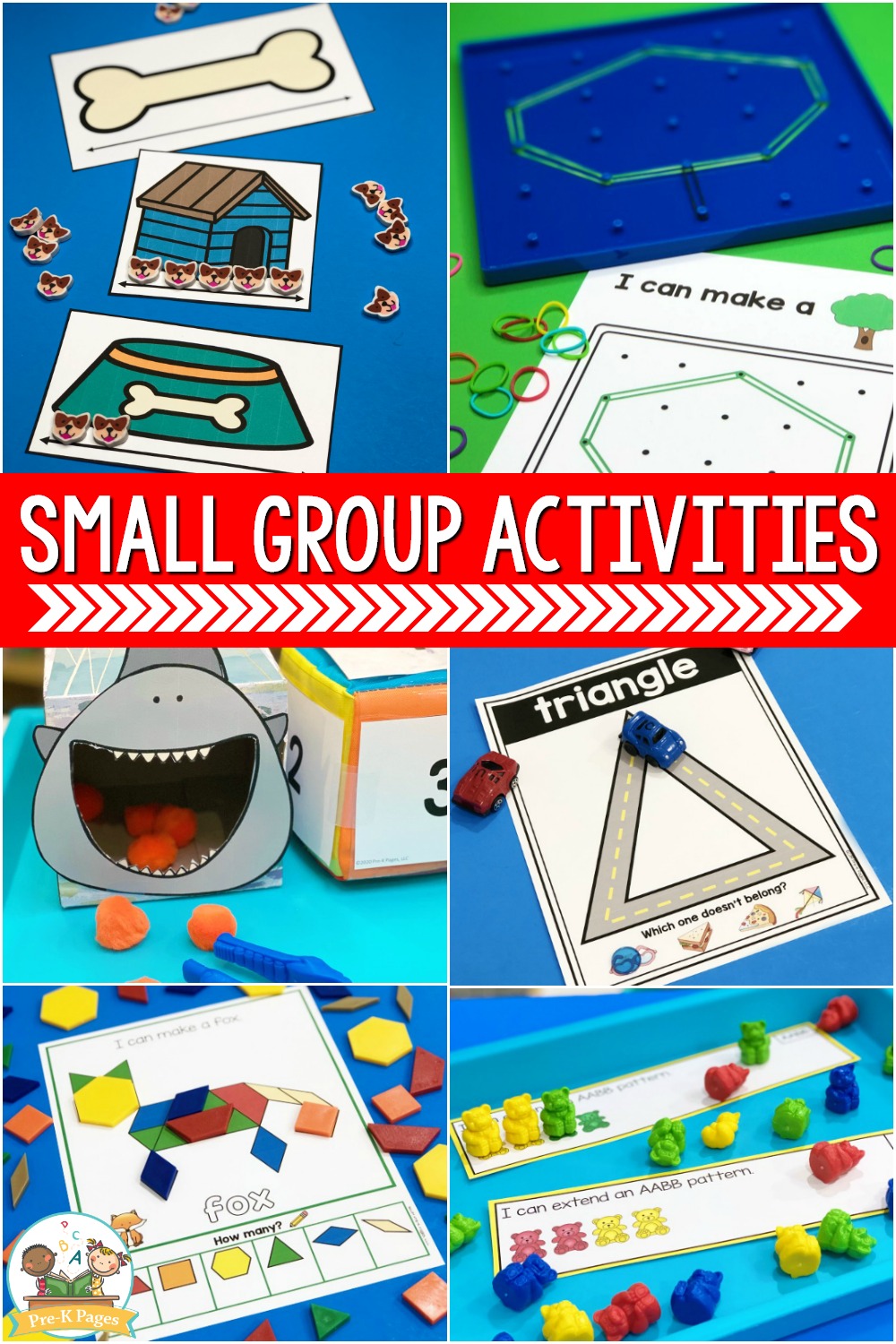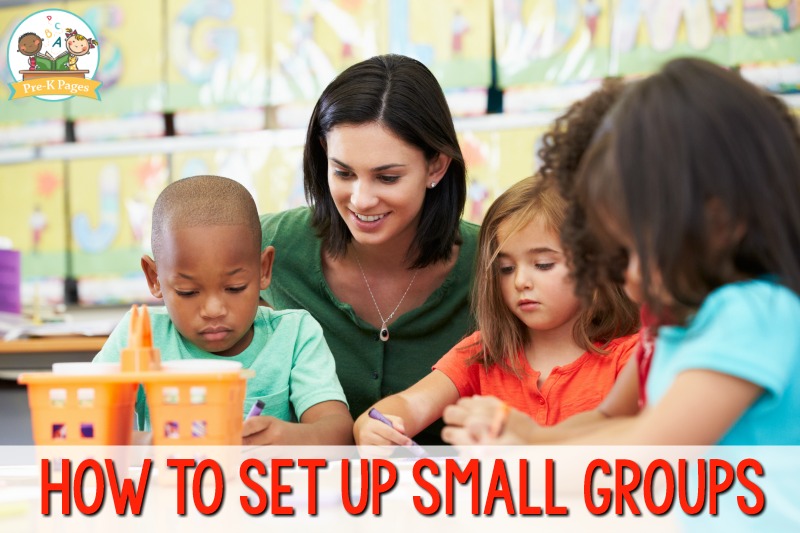Small groups are an important part of a high-quality early childhood education. But what are small groups? How many should you have? And what should you teach in your small groups? These are all good questions when it comes to planning for effective small group activities in your preschool, pre-k, or kindergarten classroom.
What Are Small Groups?
Small groups are a highly-effective instructional method that allows you to target your instruction to meet the needs and skills of each student in your classroom.

Why Small Groups Are Important
Small group activities allow you to easily differentiate instruction for your students. The benefits of daily small group instruction are much greater than those of whole group instruction. When you incorporate small group activities into your daily schedule, you’ll be able to help your preschool, pre-k, and kindergarten students learn more.
Scaffolding is another important aspect of small group instruction. When you provide specific support to help a child move to the next level of learning, this is commonly referred to as scaffolding instruction. To successfully scaffold for a child, the teacher must understand the learning continuum for each specific skill and know where each child is on that continuum.
How Many Kids in Each Small Group?
Ideally, small groups can include three to six children per group. You can divide the students in your preschool classroom into several small groups, with three to six children per group.

How Many Small Groups Should You Have?
The number of groups you have will depend on how many children are in your classroom. For example, if you have a class of 20 Pre-K students, you may have four groups of five students each, or two groups of four, and two groups of six. It’s not important how many groups you have, but rather how you’ve determined which students are in each group.
Small Group Activities
How to Group Your Students
Creating small groups is not a guessing game. A high-quality early childhood program uses assessment data to create small groups. Assessment is a tool that highly-effective teachers use to help their students get from educational point A to point B. Teaching without following assessment data is like driving a bus full of young children blindfolded.
The most efficient assessment tools will take the data you collect and create small groups for you to eliminate any implicit biases you may have. My favorite assessment tool is ESGI – and it’s super quick and easy too!

How to Set Up Small Groups
First, you’ll want to designate a place in your classroom that is specifically for small group time so your students will know where to go when it’s their turn. I try to locate my small group area away from the nosiest areas of the classroom, like blocks and dramatic play. You can use a table for your small groups, or a carpet on the floor if you prefer.
Next, you’ll need an area for your small group materials. You can prep your small group materials each Friday for the following week so they’ll be ready to go when you walk in on Monday morning. Color coded bins or baskets, a different color for each day of the week work well for storing small group materials. You could also use colorful plastic drawers for organizing your small group items.
When to Have Small Groups
Small groups are most effective when you have them daily. Find a place in your daily schedule for small group instruction. You don’t have to meet with every group every single day, just have a designated time each day when you meet with at least one or two groups.

How to Manage Small Groups
When it comes to managing small groups, there are a few important pitfalls you should try to avoid.
Pitfall #1: While it may be tempting to split your class in half and do one small group yourself, and have another adult (assistant or co-teacher) lead the other, it doesn’t align with the purpose for small groups. One of the purposes for small groups is help children learn how to work independently.
Pitfall #2: It’s easy to create your groups based on behaviors and personalities and keep them that way all year, but this approach is contrary to small group best practices. Instead, your groups should be flexible and change when necessary based on where your students are on their own individual learning continuum. We know that all young children learn at their own pace, therefore it only makes sense that not all children will travel along the same learning path at the same time. This is why we assess students more than one time during the school year, to see the progress they’ve made, and to determine what they are ready for next.
Pitfall #3: Having small groups during center time. If you try to have your small group lessons during your center time you’re going to be fighting an uphill battle. The lure of the blocks and dramatic play center are going to be too strong and your small groups won’t be successful if they’re in competition with the other centers. Instead, have more than one center time in your daily schedule if possible, one for small groups and independent work, and another for full-blown centers.
Small Group Activities
How Long Should Small Groups Be?
Your small group time should match the attention spans of your children, especially in the beginning of the school year. You may start the year with less than 10 minutes per group, but as your students begin to grow and mature, you may be able to gradually increase the time.
Small Group Activities
Small Group Activities for Preschool
Once you’ve assessed and grouped your students, it’s small group time! The most important thing is that you choose hands-on activities that are engaging and fun. If your activities are not interactive and playful, then they won’t be successful.

Small Group Examples
You can do almost any activity that the students in your small group need to learn. Everything from fine motor skills, letters, number recognition, counting, sorting, one-to-one correspondence, and more are acceptable small group activities. Here are some of my favorite small group activities below.
Free Editable Daily Schedule
Working with students in small groups should be part of your daily schedule. And when preschoolers have a predictable and consistent daily schedule in place and they know what your expecations are for each upcoming activity, they feel safe and secure and are ultimately more willing to learn.
I’ve taught both full and half-day schedules and I’ve included free editable templates of both types for you here. To have the editable schedules emailed to you, simply fill out the form below.
More Teaching Tips
Welcome to ParentingBlog. Here you will find information about pregnancy, parenting, baby tips, nutrition, health and more. We have tons of videos, articles, tips, and advice. All found in one place! Enjoy!
Shop our online store for the best deals in beauty, health, and more. SHOP NOW.















Add comment